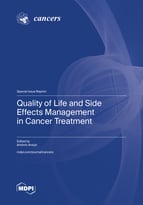Quality of Life and Side Effects Management in Cancer Treatment
A special issue of Cancers (ISSN 2072-6694). This special issue belongs to the section "Cancer Survivorship and Quality of Life".
Deadline for manuscript submissions: closed (1 June 2023) | Viewed by 23399
Special Issue Editor
2. Instituto de Ciências Biomédicas Abel Salazar, Universidade do Porto, Porto, Portugal
Interests: clinical and translational research; mechanisms and control of adverse events; strategies to improve cancer patients’ quality of life
Special Issues, Collections and Topics in MDPI journals
Special Issue Information
Dear Colleagues,
Cancer treatment has evolved in recent years in an unimaginable way, giving to our patients an increased rate of progression-free survival and/or overall survival. However, most importantly, these new drugs or new drug combinations are more patient friendly, increasing their quality of life. Nevertheless, we still have to learn how to control the adverse events involved in target therapy, immunotherapy and the new drugs of hormonotherapy.
At present, we still struggle with these adverse events when combining different drugs for immunotherapy, immunotherapy with chemotherapy, or immunotherapy with target agents. The nausea and emesis induced by chemotherapy are still stressful events that we continually try to control better; the immune-mediated toxicity, the rashes and diarrhea induced by target therapy, and the numerous forms of pain that affect most of our cancer patients are all still of significant concern and are the object of investigation.
We are, therefore, pleased to invite you to contribute to this Special Issue highlighting the current state of the art in the control of cancer treatments’ adverse events and in improving the quality of care of cancer patients, as well as future prospects for improving therapies.
You may choose our Joint Special Issue in Current Oncology.
Prof. Dr. António Araújo
Guest Editor
Manuscript Submission Information
Manuscripts should be submitted online at www.mdpi.com by registering and logging in to this website. Once you are registered, click here to go to the submission form. Manuscripts can be submitted until the deadline. All submissions that pass pre-check are peer-reviewed. Accepted papers will be published continuously in the journal (as soon as accepted) and will be listed together on the special issue website. Research articles, review articles as well as short communications are invited. For planned papers, a title and short abstract (about 100 words) can be sent to the Editorial Office for announcement on this website.
Submitted manuscripts should not have been published previously, nor be under consideration for publication elsewhere (except conference proceedings papers). All manuscripts are thoroughly refereed through a single-blind peer-review process. A guide for authors and other relevant information for submission of manuscripts is available on the Instructions for Authors page. Cancers is an international peer-reviewed open access semimonthly journal published by MDPI.
Please visit the Instructions for Authors page before submitting a manuscript. The Article Processing Charge (APC) for publication in this open access journal is 2900 CHF (Swiss Francs). Submitted papers should be well formatted and use good English. Authors may use MDPI's English editing service prior to publication or during author revisions.
Keywords
- cancer treatment adverse events
- quality of life in cancer patients
- chemotherapy adverse events
- target therapy adverse events
- immunotherapy adverse events
- hormonotherapy adverse events
- chemotherapy-induced nausea and vomiting
- cancer pain







